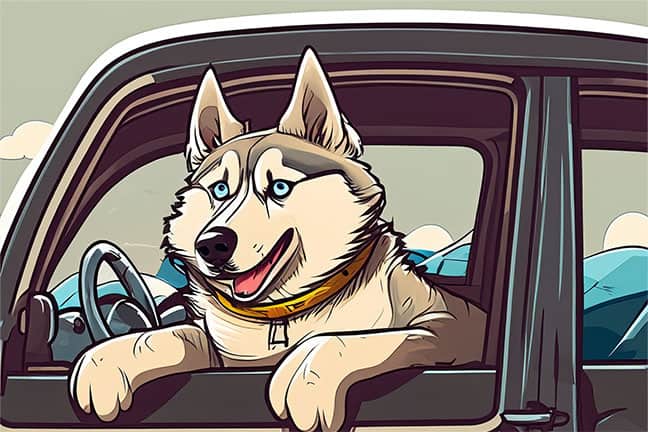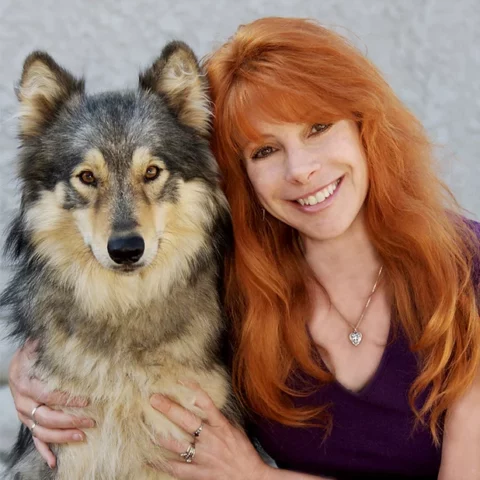Last week I wrote a post that included Sage’s fear of the car. Many of my readers wanted to know more about what we’re doing and how to handle the issue in general, so here you go!
Sage’s Protocol
We have a carport but no garage. At first, my car (actually a Toyota 4Runner SUV) had been positioned directly in front of the house. Unfortunately, Sage would bolt immediately upon seeing it. So, I moved it to where there would still be room to open the side and back doors, but it wouldn’t be the first thing she saw when leaving the house. We practiced a lot of loose leash walking, touches, and other training in the vicinity. Any time we walked in the direction of the car, if I saw even a hesitant glance, we’d turn and walk in the opposite direction, do upbeat touches and more loose leash walking, and then circle back. Sage was soon walking calmly all around the car. For the next step, I opened a back door and placed treats on the ledge below the seat. She snatched them up with no problem. I then put a few treats on the edge of the folded-down back seat. She stretched up to grab them. Eventually, she would put her paws up to get the treats, which I still kept within easy reach. When I moved them further inside, though, she would not jump in to get them.
I’d never seen Sage jump onto anything as high as an SUV. I wondered if she was afraid to try because she’d hurt herself trying to jump into a car in the past, or if there was a physical issue. To rule out jumping as the issue, I used a set of portable stairs. To get her used to them, I set them against a dog house in back of our house, far from the car. Thanks to the magic of treats, she was soon happily running up and down the steps. Then, because I’d already gotten her comfortable being around the car, I tried the steps there. I had the hatchback opened rather than a side door, because the times my husband had picked her up and put her in early on, it was through a side door. (The steps were too wide for the side door anyway.) I lured her up the steps and she went right in! We quickly got to the point that I could toss treats in and she’d run up the steps on her own to get them. At that point I thought hmm, maybe jumping was the issue…but after a few days of practice, she surprised me by foregoing the steps altogether and jumping in after the treats! After another few days of successful jumps, I closed the hatchback for just a second when she was inside and then opened it and let her out. The next step was to leave the back windows rolled down a bit and when Sage jumped into the hatchback, closing it and then quickly feeding a few treats through the back door window and letting her out the back door. We’re now gradually building up the amount of time she’s inside, with me feeding treats intermittently but frequently through the window, and then letting her out. This morning, I also put her breakfast inside the car and got her to jump in the hatchback after it. The back side windows were down, and I stood outside and watched as she ate. I probably should have sat in the front seat instead–no more behavior protocols before coffee for me–and let her out the side door when she was finished. From the initial bolting at the sight of the car to where we’re at now, it’s been around three weeks.
Our next step will probably be for me to close the hatchback with her in it and feed treats or a meal while I’m sitting in the driver’s seat, then get out and let her out a side door. I’ll eventually turn the car on and then off, then keep it running a bit longer, then move just a few feet, etc. until we can just go. It all depends on how she’s doing, and I may have to tweak the protocol along the way. The hardest thing with these protocols, at least to me, is being patient and not rushing things. But slow and steady wins the race. Now, here a few ideas that might be helpful if you’re in a similar situation.
First, a few quick notes:
– If you have a dog gate in your car and your dog’s issue stems from a feeling of panic when being enclosed–for example, he panics in a crate, or looks around frantically once inside the car– remove the gate and see if it helps. – When doing protocols involving tossing food in the car, assuming you have an enclosed space like a garage, try leaving both doors open so your dog doesn’t feel trapped. You could initially practice having him go in one door and out the other. – If your dog is also anxious in general, you might find that using an over the counter, natural calming remedy like Zylkene (purchase the right dosage for your dog) could be helpful as you work through a protocol.
If your dog has a fear of going anywhere near the car,
Here are some things to try:
- Implement the type of protocol I described, starting with training exercises at a comfortable distance, using plenty of treats. Be sure not to push too far too fast, paying careful attention to your dog’s body language and stress level. If he goes over threshold, go back a few steps in the protocol and take it slower. If your dog went over threshold and absolutely refuses altogether now, rather than pushing it, take a day or two off before trying again.
- Shape the process of getting in the car. Whether you use a clicker or a verbal, “Yes!” mark and reward tiny increments at first such as glancing toward the car, followed by rewarding even one step toward it, then more steps, sniffing the car, etc. until your dog is actually in the car. Once you reach the point where he’s approaching the car without hesitation, you could have a jackpot reward already planted in the area he’ll ride in, and then continue to click for approximations toward it.
- If your dog enjoys a game of tug, play at a distance where your dog is comfortable, gradually working your way in closer to the car. The feeling of joy a dog has during play is at odds with feeling fearful. If your dog will retrieve, you could toss the tug, a ball, or a favorite toy at a comfortable distance from the car and have him bring it back to you. Eventually, you might be able to toss it into the car for your dog to retrieve.
- If your dog knows “Touch” (targeting), teach him to touch his nose to a target, which can then gradually and incrementally be moved to the interior of the car. Once you can get your dog into the car:
- Spray the inside with Adaptil (DAP, dog appeasing pheromone). I had one client where this actually solved the entire problem immediately. I wouldn’t expect that sort of miracle, but it could certainly help. (As the product states, spray and then wait at least 15 minutes before your dog enters the car.)
- Make the car a happy place before ever turning it on. You could sit in the back with your dog and give tummy rubs, feed treats, or even feed a meal, then immediately let him out.
- Implement a protocol with baby steps in short increments and building up gradually. Steps could be closing the door with him in the back and you in the driver’s seat where you feed treats, then getting out and letting him out; turning the car on just for a few seconds; letting the engine run longer; rolling just a few feet, then turning the car off. You could even do the latter steps while allowing your dog to chew a stuffed Kong, bully stick, or favorite chew item. As your dog remains calm, don’t push too far too fast. As tempting as it may be, don’t shout, “Finally!” and take off for the park. Baby steps!
- If your dog is nervous on car rides, assuming it’s not because he’s carsick, try a Thundershirt. The body wrap can impart a sense of calm, but be sure to put it on your dog at other times first (associate it with feeding, fun, etc.) so that it doesn’t only predict a car ride. Place it on your dog at least 10 minutes before the ride so it doesn’t become associated with the car.
- Try a Calming Cap. If you’re not familiar, these caps, invented by Trish King and now sold by Thunderworks (the Thundershirt company), reduce visual stimuli. The sheer fabric allows light in but filters the vision in a way that is calming to many dogs. The material somehow always reminds me of a dog wearing a pair of Speedos on his head! But seriously, it might look a little strange but is a brilliant invention that can be helpful for other things such as nail trims, too.
- Does your dog ride in a crate? If so, covering it will cut way down on visual stimuli and could be calming. If your dog rides uncrated, you could cover the back windows with window clings or something similar, thereby creating a Calming-Cap like filter on the windows.
- Try having someone ride in the back with your dog. Some dogs will feel much calmer with a friend riding by their side.
- This should go without saying, but make sure rides end only at pleasurable destinations. Hopefully you won’t need to take your dog to the vet, for example, during the course of your behavior modification efforts. Take lots of short trips to the park, beach, forest, or wherever your dog enjoys going. If he’s food motivated, you could give him a super yummy treat that he never gets otherwise when he gets to a destination. You get the idea.
Above all, hang in there. The effort you put in now will be well worth it in the long run. I hope these ideas have been helpful. Let me know! Comment too if you have other ideas to add to the list.





